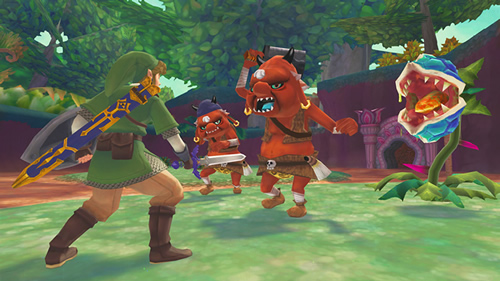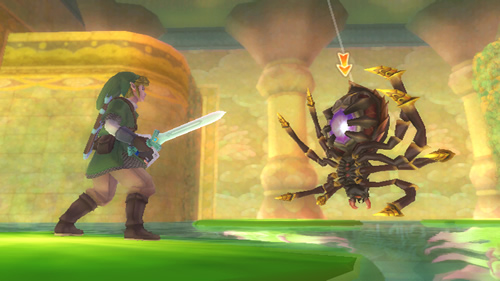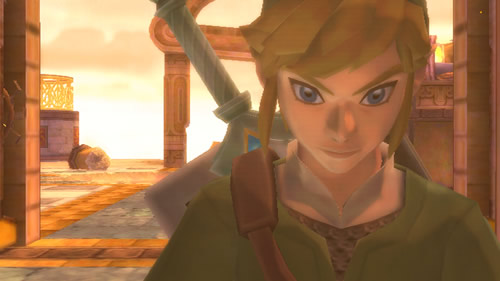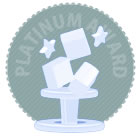The Legend of Zelda: Skyward Sword (Wii) Review
By Adam Riley  24.11.2011
24.11.2011

Did you know it is the 25th Anniversary of The Legend of Zelda this year? It would be quite surprising if Nintendo’s continual bombardment of that fact had failed to filter through to most of the Internet-enabled populace. Just in case you haven’t noticed, Nintendo has so far released an upgraded port of Ocarina of Time for 3DS, held a special symphony concert to celebrate the music from the action adventure series, put a new version of multiplayer outing Four Swords on DSiWare completely free for a limited time. Now they have unleashed a brand new Wii outing that is not only MotionPlus-enabled, but solely relies on the improved motion control system for the whole journey. After some felt Twilight Princess fell somewhat short of expectations, here is The Legend of Zelda: Skyward Sword to set matters straight before Wii reaches the end of its lifespan.
When it comes to approaching a review for any new The Legend of Zelda outing, it can prove to be quite the daunting prospect as all eyes are on whether or not Nintendo has managed to churn out an end product that trumps all previous efforts. Due to the amount of pressure on reviewers to both go into detail on the review and deliver a score to please the masses, more often than not final marks can be over-inflated. Looking back with hindsight, this was most certainly the case with The Legend of Zelda: Twilight Princess which, whilst an undoubtedly impressive addition to the timeline, re-used far too many old ideas. The Wii version clearly had motion controls tacked on so as to justify its existence at the launch of the GameCube successor, and it also grew quite tiresome after the halfway point due to the story and action elements not quite being up to the high standards set in the past. Hitherto there has been no awful Zelda games, unless the CD-i iterations from Philips count, and with The Legend of Zelda: Skyward Sword that trend is not about to abruptly abate.
Rather than merely having the idea of motion controls added as a pleasant afterthought, though, Skyward Sword actually joins the limited selection of titles on Wii that are Wii MotionPlus-only, standing alongside Ubisoft’s Red Steel 2 as it steps into the same treacherous waters as Donkey Kong 64, which required the Nintendo 64 Expansion Pak in order to be played. Thanks in part to the roaring success of Wii Sports Resort, which included the Wii MotionPlus add-on as part of its package, and the increase in sales of the Wii Remote Plus that debuted alongside FlingSmash at the tail end of 2010 and has now been incorporated into every new Wii bundle, it is a safe bet that the penetration rate of the increased motion sensitivity tool is so high that The Legend of Zelda: Skyward Sword has no chance of being the astronomical disaster that Red Steel 2 was (compared to the original) in the sales stakes.
As with Wii Sports Resort, there is an instructional video to watch before leaping into the main adventure, which eases players in to the world of MotionPlus, and there are moments where calibration of the accelerometer is required by simply placing the controller on a flat surface for a few seconds and then pointing the infra-red cursor at the centre of the screen for fine-tuning before gaining control of Link on his quest. From time-to-time, should the controller seem like it has gone out of calibration, there are several opportunities to pause the action and simply rest the controller in whatever position you feel is most natural and tap the down direction on the D-pad to re-centre the on-screen cursor. Nintendo has attempted to eliminate any of the troublesome issues that have plagued MotionPlus-enable releases in the past, and for the most part it has succeeded, with Skyward Sword definitely being the smoothest MotionPlus game on the market so far, and still miles apart from efforts released for Sony’s PlayStation Move controller to date. There may be instances where people may encounter situations where certain aspects do not work ideally, such as when rolling and throwing objects such as bombs, pots and small boulders by either pointing the Wii Remote directly down and doing a bowling motion, or up and throwing forwards like serving in tennis, but they are few and far between, differing from person-to-person.

Ever since the first days of Wii people have been dreaming of true 1:1 control of light-sabres or swords, but despite Red Steel 2 moving in the right direction, not many other developers have bothered to take advantage of the highly-tuned technology. Games such as No More Heroes: Desperate Struggle purposefully overlooked its inclusion despite the Beam Katana being perfectly suited to it. Nintendo - Shigeru Miyamoto, Eiji Aonuma and the rest of their team - have ensured that MotionPlus features are not only placed into The Legend of Zelda: Skyward Sword, but that the superbly accurate movement of Link’s blade encapsulates the entire essence of the adventure on the whole. Being able to wield a sword on-screen just as you would in reality is an extraordinary feeling, and proves itself no gimmick thanks to the integral part it plays in defeating enemies and solving puzzles on the long road ahead as Link travels from Skyloft, above the clouds, to numerous locations in the world below.
Taking flight using Link’s personal giant bird proves to be just as wondrous an act as sword usage; holding the controller directly in front and tilting accordingly to direct the bird Link perches upon, then flapping the Wii Remote up and down to make it move its wings in the same fashion to gain altitude, and then pointing downwards to rapidly gain speed. Misdirecting enemies during sword fights is also one of those unforgettable moments, as is being able to bowl bombs at varying angles, carefully timing rolls so that they explode in the right location just when you need them to. It may seem strange to mention something as casually-oriented as Wii Sports Resort in an adventure review, but Nintendo has taken control elements from that and melded them perfectly with The Legend of Zelda: Skyward Sword in the hope of drawing new people to the fold, as well as long-term fans. Elements such as these are integrated throughout the adventure, along with tweaks like the improved running system and ability to leap up ladders and vines instead of slowly climbing. These all help to drive home the point that Nintendo has attempted to produce an end product that keeps as many sectors of the gaming world as happy as possible. From the character interactions, the build up to dungeons, the humorous side-quests, the delightful conversations that can be had, to the brain-bending dungeons and face-offs against some ingenious bosses that again usually require specific use of MotionPlus to conquer, this is a gamers’ game through and through.

Comments have been made on several occasions by the development staff that trying to force a timeline into The Legend of Zelda is a fruitless task, with Link and Zelda simply being characters that awaken in varying time periods for use in differing situations. This point is driven home in Skyward Sword when the story commences up in the lofty sky island of Skyloft, an appropriately-named place above the cloud line where there is no conflict and everyone remains healthy under the belief that a Goddess is watching over them. Zelda is the daughter of the local headmaster and Link is simply another budding student eager to become a soldier to watch over the land, taking part in a flying competition in order to win the privilege of becoming a Skyloft Knight, and draw closer to his childhood friend, Zelda. There is quite a lengthy introductory period to ease players into the new MotionPlus control system and to also help them acclimatise to the surroundings, become accustomed to the flight mechanic when Link rides through the skies, and gain a general bond with villagers. Whilst it may sound long-winded and rather unnecessary to some, the skill with which the initial stages are interlaced with random little objectives is striking, with the tutorial element being so seamlessly integrated into the experience that the early hand-holding side is not overly apparent until Zelda is whisked away to the land beneath the clouds and the real journey commences.
For those that have been on a total Zelda blackout, dodging the numerous informational leaks that have been spreading around the Internet like wildfire over the past month or so, their patience will indeed be rewarded. The Legend of Zelda: Skyward Sword very subtly draws you in with its laidback approach to story-telling, creating a real sense of the player being the one right there in the midst of the current goings-on. Nothing is forced, conversations are not overly text-heavy, and there is a whimsical feel to interactions between non-playable characters and Link that helps to keep the gamer in a relaxed state, perfect for enjoying proceedings without boredom creeping in. Skyward Sword serves up just enough intrigue to draw players further into the tale, whilst providing gentle directional reminders to prevent people from going off-track and heading down that oft-frustrating route of mindless meandering that plagues some RPGs and objective-based adventures.
Nintendo has had to be extremely careful with The Legend of Zelda over the years due to outcries from the fan-base, some of whom wish to see a more cartoon-esque Link, as found in The Legend of Zelda: Wind Waker on GameCube, and others that desperately seek a high definition iteration of the series that turned 25 this year, with the reaction to the Wii U demonstration version from 2011’s E3 event clearly showing the visual stance some corners want Nintendo to take. The split between factions, however, has left Nintendo unsure how to proceed with future games and after opting for a more mature setting with Twilight Princess, Phantom Hourglass and Spirit Tracks on the Nintendo DS both returned to the Wind Waker cartoon-like appearance. For The Legend of Zelda: Skyward Sword, Nintendo has attempted to satiate the desires of all demographics, mixing the appearance of an adult Link and Zelda with the soft, pastel cel-shading effect found in Super Mario Galaxy 2 that gave proceedings a bright air, yet a wonderfully soft touch that made the graphics a delightful treat for the eyes.

The subtle nuance in the visual composition of Skyward Sword is breath-taking in many places, with Link and Zelda both looking extremely life-like compared to previous games, yet somehow still retaining their animated charm from past games; their expressiveness toned down from Wind Waker but expanded over past stabs at ‘realism’. The rest of the world continues with a fantastical theme, almost becoming like a canvas for Nintendo’s artists to paint their vibrant vision. The locations around both the sky-based areas and those on the ground that must be explored are equally as pleasing, with Nintendo’s usual intricate levels of detail being present and correct, ranging from the raging fiery molten lava to delicate leaves falling from bushes and trees when rolled into. It is clear that many years of care and attention have been placed into this project, and the end result is on par with other Wii greats, such as Xenoblade Chronicles. Skyward Sword also excels aurally, as would be expected given how strong previous games’ soundtracks have been, but with the mix of familiar themes and a whole host of new tunes, including the beautifully soft, lilting Ballad of the Goddess, the harmonies throughout are of the utmost quality.
No matter how aesthetically and aurally splendid The Legend of Zelda: Skyward Sword is, in spite of the fact that the storyline is absorbing, and even though the new control mode breathes new life into the 25-year-old series, it would be all for nothing if there was barely any challenge. As with pretty much every Mario game, Zelda titles are not renowned for their stiff difficulty setting, relying more on complex dungeon designs and lengthy quests to keep players entertained for long periods. Skyward Sword is not dissimilar to this, since reaching the conclusion of the adventure may have the odd moment where there is a modicum of extra toughness included, but it is hardly a mammoth task to reach the final stages to ultimately save the day. As opposed to piling up empty, meaningless extra quests to elongate the longevity, though, Nintendo has created a healthy batch of highly engaging objectives that add extra life to the game. Meeting and helping people to receive their thanks in the form of Gratitude Crystals, switching times of day to trigger specific events, testing your sword skills, trying your luck, finding all sorts of weird and wonderful items and creatures; they are all pretty standard inclusions, yet the way they have been incorporated is what makes them so special, with that extra Nintendo touch working wonders.
The Legend of Zelda: Skyward Sword is a fantastic prospect for all Wii owners; not just the faithful quarter that have followed the series since its initial inception, but those who lapped up the expansive world of Xenoblade Chronicles through to people who were enamoured by the MotionPlus features of Wii Sports Resort and are looking for something that has somewhat similar controls, but used in a deep and meaningful manner. Nintendo has delivered with Skyward Sword on so many levels that any minor gripes with re-calibration or slow-moving story moments can easily be brushed under the carpet and forgotten about. It may not be the pinnacle of Wii games so far, but it definitely resides in the upper echelons of the system’s catalogue.

Cubed3 Rating
Masterpiece - Platinum Award

The beauty of The Legend of Zelda: Skyward Sword is that it extracts the key core elements that make the series so impressive in the first place and brings along a large dose of familiarity, but then goes on to mix in a whole host of newly-styled dungeons, brand new puzzles that appeal to a broad audience, as well as superb 1:1 sword control that actually needs to be mastered for progression rather than being added as a gimmick or just for show and a twist on the normal storyline. Nintendo has taken on-board the feedback from fans and critics alike following Twilight Princess’ release and used it to create one of the best Zelda games ever, if not the best.

![]() 10/10
10/10
![]() 9/10
(28 Votes)
9/10
(28 Votes)
 Out now
Out now  Out now
Out now  Out now
Out now  Out now
Out now Comments
Comments are currently disabled

 Sign In
Sign In Game Details
Game Details Subscribe to this topic
Subscribe to this topic Features
Features





 Top
Top

